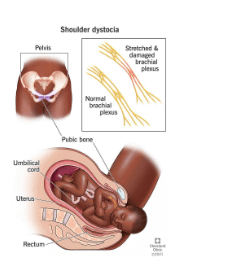Causes and risk factors
Causes and risk factors ( 9 Questions)
A nurse is assessing a client who is in labor and has a large baby with a cephalopelvic disproportion (CPD).
The nurse should monitor the client for signs of which of the following fetal complications?
This is a complication that can occur when the baby’s head is delivered but one or both shoulders becomes “stuck” behind the pelvic bone. This can happen when the baby is too large or out of position when entering the pelvis, which are possible causes of cephalopelvic disproportion (CPD).
it is a complication that occurs when the umbilical cord slips through the cervix before the baby does. This can happen when the baby is in a breech position (feet or buttocks first) or when the amniotic sac breaks early.
It is not related to CPD.
it is a general term that describes signs of decreased oxygen supply to the baby during labor. It can have many causes, such as cord compression, placental abruption, infection, or maternal health problems.
It is not specific to CPD.
it is a condition that occurs when there is too much cerebrospinal fluid in the brain, causing increased pressure and swelling.
It can have many causes, such as genetic defects, infections, bleeding, or trauma.
It is not related to CPD.
This is a complication that can occur when the baby’s head is delivered but one or both shoulders becomes “stuck” behind the pelvic bone. This can happen when the baby is too large or out of position when entering the pelvis, which are possible causes of cephalopelvic disproportion (CPD).
Normal ranges for fetal head circumference are 32 to 38 cm at term.
Normal ranges for maternal pelvic inlet diameter are 11 to 13 cm for anteroposterior diameter and 13 to 14 cm for transverse diameter.

